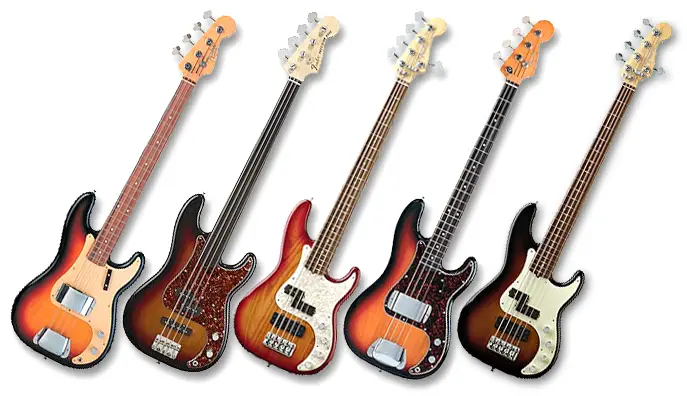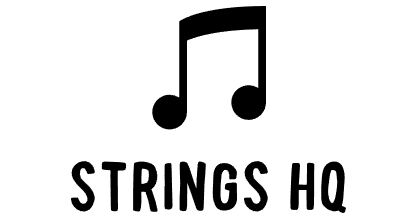There’s an endless number of expensive gadgets you can purchase for the bass guitar. These range from special effect pedals to preamp pedals, costing thousands of dollars.
However, there are only a handful of items you need to play most music to a high quality on the bass guitar. Here we’ve listed (in order of importance) the 7 most essential things you need to start playing bass.
A bass guitar, strap, instrument cable, and an amplifier are necessary items you need to start playing the bass guitar. With these, you’ll be able to correctly hold the instrument and produce sound. Other important items include a tuner, a metronome, a pick, and a practice book.
Read on to understand more about the most essential items you should be purchasing, and how to ensure they last for years to come.
1. The Bass Guitar
There are many choices of bass guitars and many brand names. It’s easy to get caught up in detailed research, but here are two important tips for buying your first bass guitar:
- You get what you pay for. Expect to spend $300 or upwards on a decent bass guitar. Anything less and it’s going to be cheap and nasty.
- Try before you buy. Whilst this may be challenging for a beginner, you can still hold the guitar and feel the build quality. It’s important to buy something you’ll enjoy playing.
We’d recommend sticking to well-known brands such as Yamaha, Fender/Squier, and Cort (Ibanez, Schecter, and LTD are all made by Cort).
Take note of whether the bass is active or passive. Active bass guitars have an onboard pre-amp needing a 9v battery and will drain if plugged into the amp for too long.
Note: Once you buy a bass guitar, write down the serial number in case it gets stolen.

2. An Amplifier
Whilst it is possible to play the bass guitar without an amp, the instrument does not produce much noise on its own. We’d therefore recommend purchasing a small combo or a headphone-based system for practice.
Look for an amp with at least 10-inch speakers. Bass guitars produce low audio frequencies so need larger speakers than standard electric guitars.
Tip: the two most important measures in amps are speaker configuration and power output. ‘115’ means 1 x 15″ speaker and ‘810’ means 8 x 10″ speakers.
Fender, Ampeg, Hartke and GK are all solid brands. Go for a big, well-known brand to ensure build quality and longevity. Expect to spend around $200. It’s definitely worth buying a quality amp because it will last many years.
For starting out, the sweet spot in combo amps for price/value seems to be the Ampeg BA-110 and the Fender Rumble 40. Both are small 40-watt combos that list for $200 USD and have Aux In and Headphone Jacks. The Rumble 40 also has a Line Out jack that can be plugged into recording interfaces or PA systems for larger shows.

3. Instrument Cable
The instrument cable connects your bass guitar to your amplifier.
Whilst we’d recommend purchasing a good quality cable, you don’t need a top-of-the-line gold-plated cable costing upwards of $75.
A simple 10-foot, quarter-of-an-inch cable will be more than adequate. Look for a sturdy cable with protection around the ends.
4. Bass Guitar Strap
Unless playing seated (rare for bass guitarists) a strap will be required to hold the bass guitar.
Look for a basic strap 3 or 4 inches wide. A low-cost strap (around $30) from a well-known brand such as Ibanez will last you years to come.

5. Tuner
A tuner helps players tune their strings before playing. Bass guitar strings must be tuned before each time you play, as they slip out of tune gradually.
It requires a trained ear to tune strings and therefore we’d recommend purchasing a digital tuner. A tuner tells players exactly how to tune strings enabling perfect tuning every time.
One budget option is to use an app tuner such as ‘GuitarTuna‘. This is free and easy to use.
A clip-on tuner costs around $15 and works a lot better than using a smartphone tuner. It’s also far easier to tune in a band setting with a clip-on tuner. Using a smartphone requires the user to play notes at full volume whereas notes can be played quietly with a clip-on.
6. Metronome
The bass guitar is often responsible for maintaining a steady rhythm in modern music. It’s very easy to sway slightly off track and a metronome is a great way of staying on point.
There are many free phone apps available (such as ‘The Metronome by Sound Brenner‘) or you can purchase yourself an inexpensive metronome to keep in your carry case.
7. Practice Book
The first few months of playing bass will consist of your body getting used to the required movements. Your fingers will need to become much stronger before muscle memory kicks in.
Whilst it is possible to learn bass by ear (i.e. without the ability to read musical notation) we’d recommend learning how to read music immediately:
- Reading music notation makes it far easier for you to play in a band.
- Your approach to rhythm and neck knowledge improves dramatically.
Two very well-known bass guitarists with fantastic books are Ed Friedland (check out ‘Bass Guitar Series) and Hal Leonard.
Round Up
Whilst it’s easy to get bogged down in endless research, focus on the most essential items required to start playing bass.
Look for well-known brands and try to buy second-hand if possible (with the help of an experienced friend).
